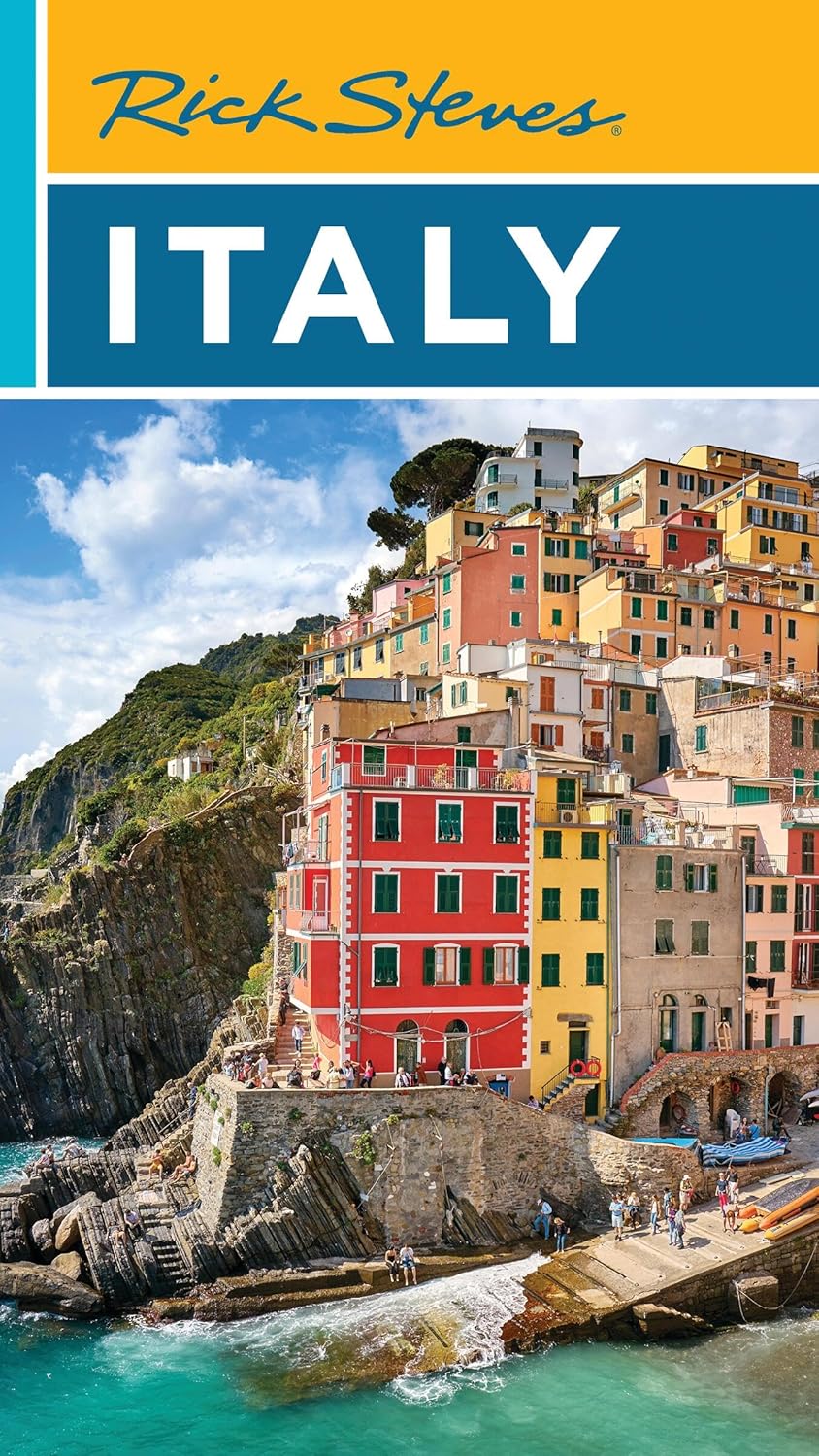What To Do In Florence, Italy
What to do in Florence.
Florence has an unparalleled blend of art, history, and culture. When you're wondering what to do in Florence, you'll quickly discover that this enchanting Italian city offers experiences that will leave you breathless at every turn.
From world-renowned museums housing masterpieces by Michelangelo and Botticelli to charming cobblestone streets lined with artisan workshops, Florence delivers an unforgettable journey through time.
The magnificent Duomo, officially known as the Cathedral of Santa Maria del Fiore, stands as Florence's most iconic landmark and should top your list of things to do in Florence. This architectural marvel, with its distinctive red-tiled dome designed by Brunelleschi, dominates the city's skyline and offers visitors the chance to climb 463 steps to reach the top.
The panoramic views from the dome are absolutely spectacular, providing a bird's-eye perspective of the terracotta rooftops and rolling Tuscan hills beyond.
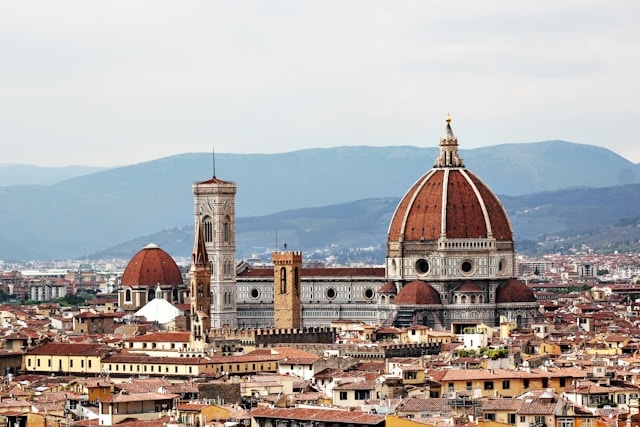 The Duomo in Florence
The Duomo in FlorenceInside the Duomo, you'll find stunning frescoes depicting the Last Judgment, painted by Giorgio Vasari and Federico Zuccari. The intricate marble floors and soaring Gothic architecture create an atmosphere of reverence and wonder.
Don't miss the opportunity to visit the adjacent Baptistery of San Giovanni, famous for its bronze doors known as the "Gates of Paradise," crafted by Lorenzo Ghiberti.
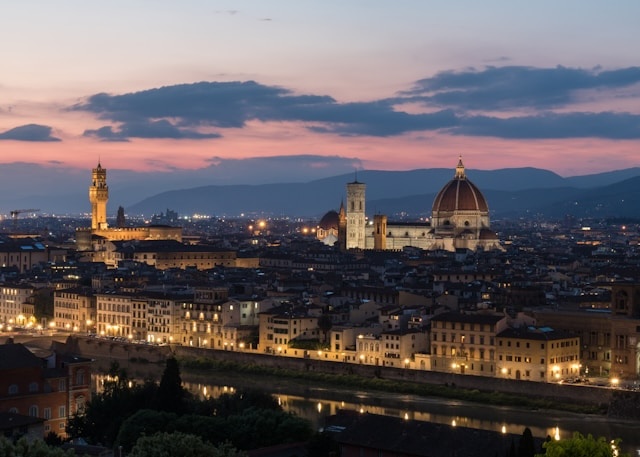 Florence at sunset
Florence at sunset
What To Do In Florence, Italy
The Uffizi Gallery represents one of the world's most important art collections and is essential when considering what to see in Florence. Home to works by Leonardo da Vinci, Michelangelo, Raphael, and Botticelli, this museum houses treasures that defined the Renaissance period. Botticelli's "Birth of Venus" and "Primavera" are among the most celebrated pieces you'll encounter during your visit.
Here's an insider tip most tourists don't know: book your Uffizi tickets well in advance and consider visiting during the late afternoon or evening hours when crowds tend to thin out.
The museum also offers special exhibitions and after-hours tours that provide a more intimate experience with these masterpieces. Take your time in each room, as rushing through this incredible collection would be a disservice to both the art and your experience.
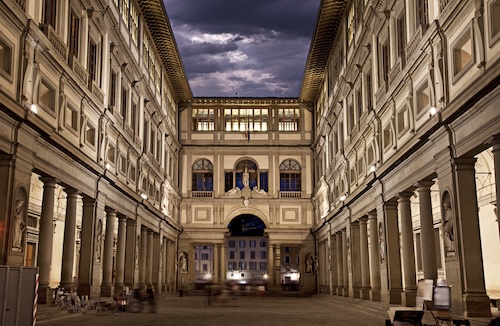 The Uffizi gallery at night
The Uffizi gallery at nightThe Ponte Vecchio, Florence's oldest bridge, offers a unique shopping experience unlike anywhere else in the world. This medieval stone bridge, spanning the Arno River, is lined with jewelry shops that have operated here for centuries.
The bridge's distinctive appearance, with buildings constructed directly on top of it, creates a picturesque scene that's perfect for photography, especially during golden hour.
Walking across the Ponte Vecchio at sunset provides one of Florence's most romantic moments. The warm light reflecting off the Arno River and illuminating the bridge's ancient stones creates an atmosphere that has inspired countless artists and writers throughout history.
Many visitors don't realize that the bridge also houses the Vasari Corridor, a secret passageway built for the Medici family that connects the Uffizi to the Pitti Palace.
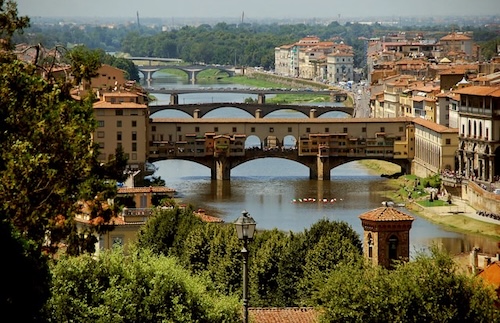 The Ponte Vecchio
The Ponte VecchioWhat To Do In Florence, Italy
The Accademia Gallery deserves a prominent place on your Florence itinerary, primarily because it houses Michelangelo's original "David" statue. This 17-foot-tall marble masterpiece, completed in 1504, represents the pinnacle of Renaissance sculpture and continues to awe visitors with its incredible detail and artistic perfection. The statue's placement in the gallery's main hall creates a dramatic reveal that never fails to impress.
Beyond the famous David, the Accademia contains other significant works by Michelangelo, including his unfinished "Prisoners" sculptures. These pieces offer fascinating insights into the artist's creative process and demonstrate his belief that sculptures already existed within the marble, waiting to be freed. The gallery also features works by other Renaissance masters and provides context for understanding Florence's artistic heritage.
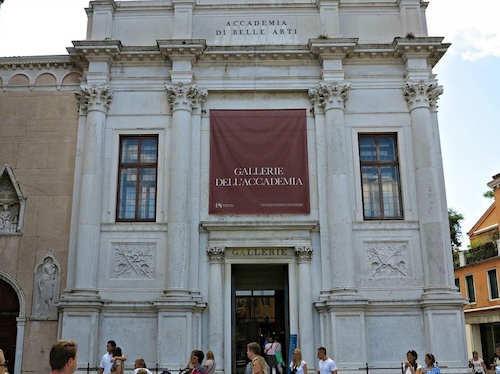 Accademia Gallery
Accademia GalleryThe Pitti Palace complex offers a comprehensive cultural experience that many visitors overlook in favor of more famous attractions. This massive Renaissance palace houses multiple museums, including the Palatine Gallery with works by Raphael and Titian, the Royal Apartments showcasing opulent Medici living spaces, and the Modern Art Gallery featuring 19th and 20th-century Italian works.
What To Do In Florence, Italy
The Boboli Gardens, located behind the Pitti Palace, provide a peaceful escape from Florence's bustling streets. These formal Italian gardens, designed in the 16th century, feature sculptures, fountains, and carefully manicured landscapes that offer stunning views over the city.
The gardens represent one of the earliest examples of Italian garden design and influenced garden architecture throughout Europe.
San Lorenzo Market and the nearby Central Market create a vibrant atmosphere where you can experience authentic Florentine life. The outdoor market offers leather goods, souvenirs, and local crafts, while the covered Central Market houses food vendors selling fresh produce, meats, cheeses, and prepared foods. The second floor features restaurants and food stalls where you can sample traditional Tuscan cuisine.
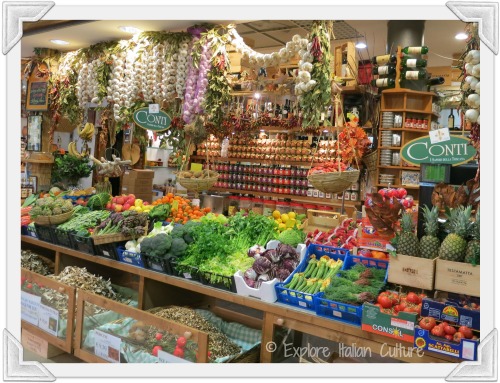 Vegetable stall at the market
Vegetable stall at the marketFor an authentic culinary experience, head to the Central Market's second floor during lunch or dinner hours. Here, local vendors serve everything from fresh pasta and risotto to traditional Florentine steak and local wines.
This bustling food hall provides an opportunity to mingle with locals and experience Florence's contemporary food scene while staying true to traditional flavors and preparation methods.
The Oltrarno district, located on the south side of the Arno River, offers a more authentic and less touristy Florence experience. This neighborhood maintains its traditional character with artisan workshops, antique shops, and local trattorias that have served the community for generations. Walking through these narrow streets provides glimpses into daily Florentine life that many tourists never discover.
In the Oltrarno, you'll find working artisans crafting leather goods, jewelry, and traditional Florentine paper products using techniques passed down through generations.
Many workshops welcome visitors to observe their craft, and some offer hands-on experiences where you can create your own souvenirs. This area also features some of Florence's best restaurants, often frequented more by locals than tourists.
What To Do In Florence, Italy
Santa Croce Basilica, known as the "Temple of Italian Glories," houses tombs of famous Italians including Michelangelo, Galileo, and Machiavelli. This Franciscan church features stunning frescoes by Giotto in the Bardi and Peruzzi chapels, representing some of the earliest examples of Renaissance painting.
The church's Gothic architecture and spiritual atmosphere provide a contemplative contrast to Florence's busier attractions.
The Piazza della Signoria serves as Florence's political heart and outdoor sculpture museum. This L-shaped square features the imposing Palazzo Vecchio, Florence's town hall, along with the Loggia dei Lanzi, which displays classical and Renaissance sculptures.
The replica of Michelangelo's David stands guard at the palace entrance, while Neptune's Fountain anchors the square's center.
Climbing the tower of Palazzo Vecchio offers spectacular views over Florence and provides insights into the city's political history. The palace's interior features elaborately decorated rooms, including the Hall of the Five Hundred with its massive frescoes depicting Florentine military victories.
Top tip: Many visitors don't realize that secret passages and hidden rooms can be explored through special tours that reveal the building's fascinating secrets.
The Santo Spirito neighborhood exemplifies authentic Florentine living and should be included in your exploration of what to do in Florence. This area features the beautiful Santo Spirito church designed by Brunelleschi, along with a lively piazza that hosts a daily market and evening aperitivo culture. The neighborhood's restaurants and bars cater primarily to locals, offering genuine Tuscan hospitality and cuisine.
Piazzale Michelangelo provides the most famous panoramic view of Florence and represents a must-visit destination for photographers and sunset enthusiasts.
This elevated square, accessible by car, bus, or a scenic walk up from the city center, offers unobstructed views of the Duomo, Ponte Vecchio, and the entire historic center. The bronze replica of Michelangelo's David serves as a focal point for this scenic overlook.
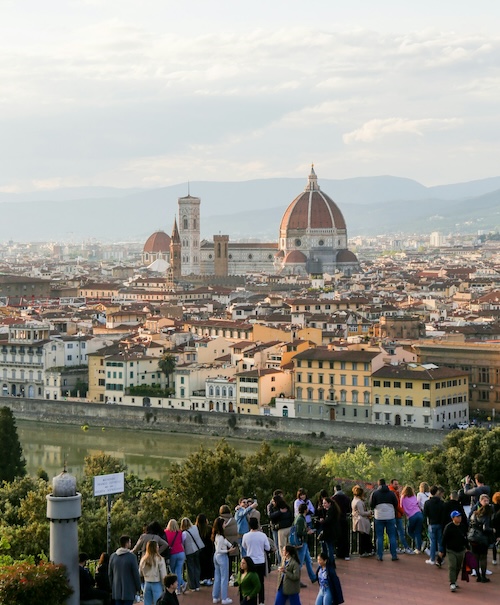 Piazzale Michelangelo
Piazzale MichelangeloFor the best experience at Piazzale Michelangelo, arrive about an hour before sunset to secure a good viewing spot and watch as the golden light transforms Florence's skyline.
Street vendors sell local wines and snacks, creating a festive atmosphere as visitors gather to witness one of Italy's most beautiful sunsets. The walk back down to the city center after dark offers romantic views of Florence's illuminated monuments.
The Medici Chapels provide insights into Florence's most powerful family and showcase some of Michelangelo's finest sculptural work. The New Sacristy, designed by Michelangelo, contains the tombs of Lorenzo and Giuliano de' Medici, featuring allegorical sculptures representing Day, Night, Dawn, and Dusk. These masterpieces demonstrate Michelangelo's evolution as both architect and sculptor.
San Miniato al Monte, perched high above the city, represents one of Florence's most beautiful and peaceful churches. This Romanesque basilica, dating from the 11th century, features stunning marble inlay work and offers spectacular views over Florence.
The adjacent cemetery and the church's elevated position create a serene atmosphere that provides respite from the city's crowds.
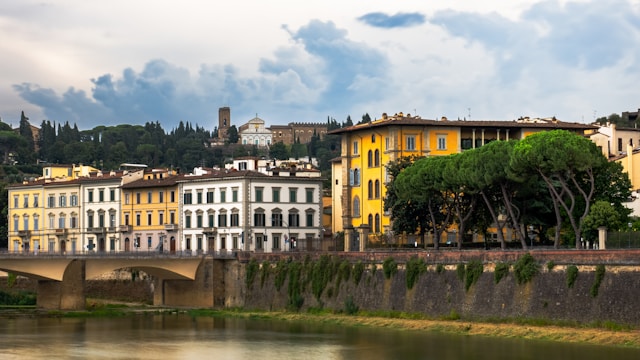 The Arno river with San Miniato in the distance
The Arno river with San Miniato in the distanceWhat To Do In Florence
Florence's food scene extends far beyond tourist restaurants, and discovering authentic trattorias requires venturing into residential neighborhoods. Look for establishments where locals dine, often identified by handwritten menus, simple decor, and the absence of multilingual signs.
These hidden gems serve traditional dishes like ribollita, pappa al pomodoro, and bistecca alla fiorentina prepared according to time-honored recipes.
The aperitivo tradition represents an essential cultural experience when considering things to do in Florence. Between 6 and 8 PM, locals gather at bars and wine shops for pre-dinner drinks accompanied by complimentary appetizers. This social ritual provides opportunities to mingle with Florentines while sampling local wines and traditional snacks in a relaxed, convivial atmosphere.
Exploring Florence's artisan workshops offers unique insights into traditional craftsmanship that has continued for centuries. Many workshops specialize in bookbinding, paper marbling, leather working, and jewelry making using techniques passed down through generations. Some artisans offer classes where visitors can learn these traditional skills and create personalized souvenirs.
 the Bardini gardens in Florence
the Bardini gardens in FlorenceThe Bardini Garden provides a lesser-known alternative to the more crowded Boboli Gardens while offering equally spectacular views over Florence. This hillside garden features a dramatic baroque staircase, ancient wisteria tunnels, and panoramic terraces that provide perfect photo opportunities. The garden's peaceful atmosphere and stunning vistas make it an ideal spot for reflection and relaxation.
Day trips from Florence open up the broader Tuscan region and its renowned attractions. The medieval hill towns of San Gimignano and Siena offer glimpses into Tuscany's rich history, while the Chianti wine region provides opportunities for vineyard visits and wine tastings. These excursions can be accomplished by rental car, organized tours like Viator, or public transportation, each offering different perspectives on Tuscan culture.
Florence Vespa Tour: Tuscan Hills and Italian Cuisine
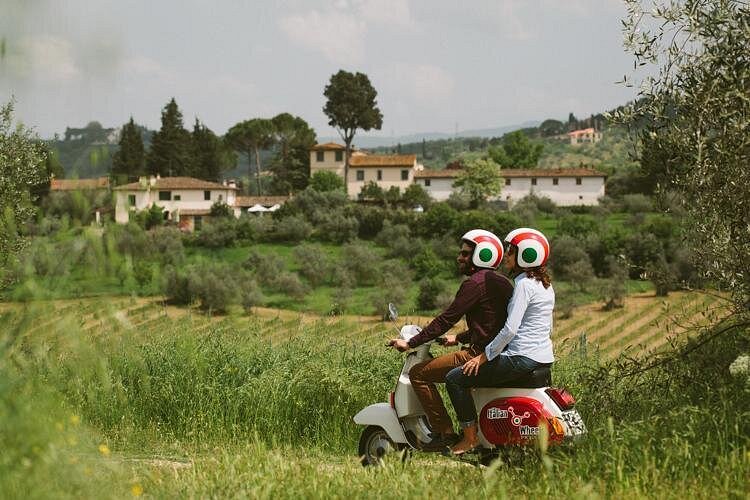 A fun Florence Vespa Tour!
A fun Florence Vespa Tour!Ride your own Vespa through Tuscany on this group tour from Florence. A local guide leads the way up through the scenic hills, where you pass the famous Piazzale Michelangelo and the Church of San Miniato al Monte. Afterward, head back to our country estate for a traditional Italian meal to top off your journey.
- Follow your guide into the Tuscan hills while driving your own Vespa
- See off-the-beaten-path sights such as the Church of San Miniato al Monte
- Enjoy a Tuscan meal at a country estate
- Stay in contact with the guide via a 2-way radio
Read more about - Florence Vespa Tour: Tuscan Hills and Italian Cuisine
Click here or on the banner below for more information and to book with our trusted partner Viator.
This tour is very popular with our readers!
Florence's evening entertainment extends beyond dining to include opera performances at Teatro del Maggio Musicale Fiorentino, classical concerts in historic churches, and contemporary cultural events throughout the city.
Many venues offer performances in atmospheric settings that enhance the artistic experience, such as concerts in Renaissance courtyards or opera in historic theaters.
Shopping in Florence ranges from high-end fashion boutiques on Via de' Tornabuoni to local markets and artisan workshops. The city's leather goods, particularly from the San Lorenzo Market area, represent excellent value and quality.
However, discerning shoppers should seek out smaller workshops where artisans create custom pieces using traditional techniques and premium materials.
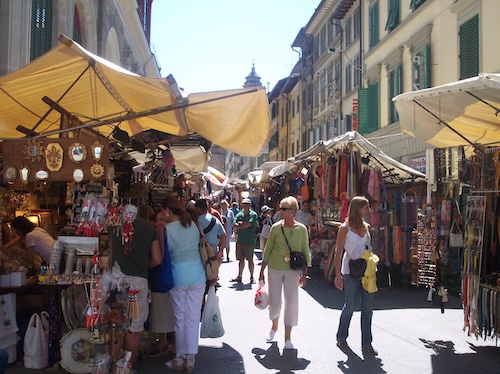 San Lorenzo market
San Lorenzo marketThe best times to visit Florence depend on your priorities and tolerance for crowds.
- Spring and Fall offer pleasant weather and manageable tourist numbers.
- Summer brings peak crowds but extended daylight hours for sightseeing.
- Winter provides the most authentic local experience with fewer tourists, though some attractions may have reduced hours.
Practical considerations for visiting Florence include booking major attractions in advance, wearing comfortable walking shoes for cobblestone streets, and learning basic Italian phrases to enhance interactions with locals.
Many churches require modest dress, so pack appropriate clothing for religious sites. The city center is largely pedestrian-friendly, making walking the best way to explore most attractions.
Florence rewards visitors who take time to absorb its atmosphere rather than rushing between major sights. Sit in a piazza with a coffee, observe daily life unfolding around you, and allow yourself to be surprised by unexpected discoveries.
The city's magic lies not only in its world-famous attractions but also in the countless small moments that reveal why Florence continues to captivate travelers from around the globe.
Whether you're admiring Renaissance masterpieces, savoring authentic Tuscan cuisine, or simply wandering through medieval streets, Florence offers experiences that will enrich your understanding of art, history, and Italian culture for years to come.



